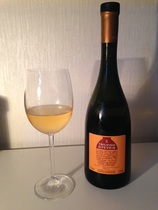A few weeks ago I was chatting to a work colleague and his lovely partner about wine. On hearing that I knew a little bit about the subject they were keen to tell me about an 'orange wine' that they had tried but they were unsure what it was. I explained the process to them then confessed that I hadn't tried any myself. Last night they came round for a meal and, in the most perfect-guesty way possible, brought me a couple of bottles to try. Fantastic!
You will have to excuse me if you know a little, or a lot, of what I am about to say but it's important to understand that this wine, firstly, is NOT made of oranges! Let's look at the basics of wine-making. White wine is made with any grape, any colour and it is only the juice of the grapes that is fermented and so any colour which may be on the skins does not appear in the wine. Red wine is made of red grapes and the juice is left in contact with the skins. This adds lots of things to the wine, colour is the most obvious one but it also adds body and texture and tannins (these produce the gum-drying experience you have after drinking red wine, or tea!). Some red grapes with thin skins produce light intensity of colour - like Pinot Noir for example; some are big hefty grapes with dark colour and thick skins - step forward Cab Sav. Now orange wine is made with white grapes but, and here's the exciting twist, the juice is left in contact with the skins (and the pips and stalks and all) to produce an extremely unusual white wine which has body and texture. Generally these wines are from Georgia and are made in Kvevris, these are massive earthen pots which are buried underground while the fermenting takes place. They are also lined with beeswax which, I think, effects the taste of the wine.
You will have to excuse me if you know a little, or a lot, of what I am about to say but it's important to understand that this wine, firstly, is NOT made of oranges! Let's look at the basics of wine-making. White wine is made with any grape, any colour and it is only the juice of the grapes that is fermented and so any colour which may be on the skins does not appear in the wine. Red wine is made of red grapes and the juice is left in contact with the skins. This adds lots of things to the wine, colour is the most obvious one but it also adds body and texture and tannins (these produce the gum-drying experience you have after drinking red wine, or tea!). Some red grapes with thin skins produce light intensity of colour - like Pinot Noir for example; some are big hefty grapes with dark colour and thick skins - step forward Cab Sav. Now orange wine is made with white grapes but, and here's the exciting twist, the juice is left in contact with the skins (and the pips and stalks and all) to produce an extremely unusual white wine which has body and texture. Generally these wines are from Georgia and are made in Kvevris, these are massive earthen pots which are buried underground while the fermenting takes place. They are also lined with beeswax which, I think, effects the taste of the wine.
| Let's be straight. This wine would be VERY disappointing if you were expecting a lovely refreshing white and you didn't know what you were buying. However, with the knowledge you now have from the paragraph above you are ready to taste with real interest and understanding. The nose is really unusual, there is quince and apricot along with a sort of honeyed sweetness. When you first taste you notice the tannins straight away. They are full frontal and so unexpected! The taste, for me, has a lovely honeyed tone - almost like mead - but there is also some apricot and a sort of mentholly bite at the back of the throat. |
This is not the most complex of wines but is refreshing and hearty at the same time. I'm led to believe that it's not the best example of orange wine you can buy; however it does have the advantage of being, I think I'm right in saying, the ONLY example that you can readily buy in a Supermarket - the lovely M&S. Do go out and buy some and let me know what you think! Now I just need to source the brandy that, apparently, is made from the rescued skin, pips and stalks at the end of the process - yum!


 RSS Feed
RSS Feed